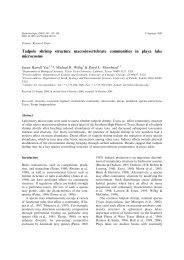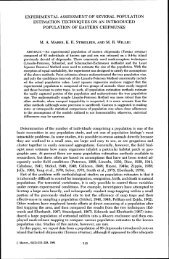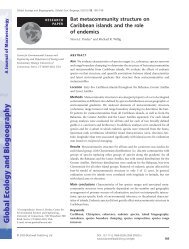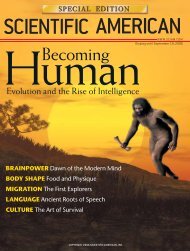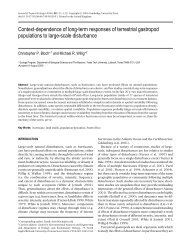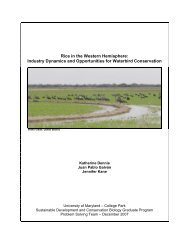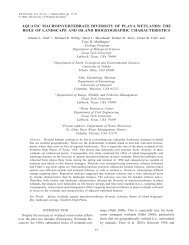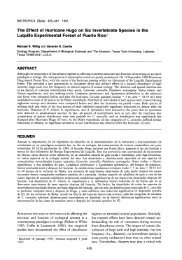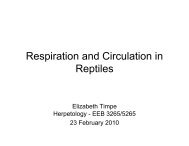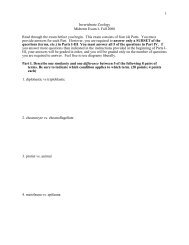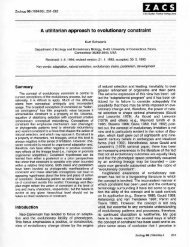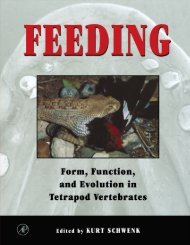Comparative biology and the importance of cladistic classification: a ...
Comparative biology and the importance of cladistic classification: a ...
Comparative biology and the importance of cladistic classification: a ...
Create successful ePaper yourself
Turn your PDF publications into a flip-book with our unique Google optimized e-Paper software.
CLADISTIC CLASSIFICATION 79<br />
between <strong>the</strong> Iguania <strong>and</strong> <strong>the</strong> Scleroglossa. This phylogenetic information has<br />
forced a new interpretation <strong>of</strong> <strong>the</strong> available data (e.g. Schwenk, 199313). In<br />
many cases, original conclusions are corroborated, in o<strong>the</strong>rs <strong>the</strong>y are suspect.<br />
The principal difference communicated by <strong>the</strong> monophyletic taxon<br />
‘Scleroglossa’ versus <strong>the</strong> paraphyletic taxon ‘Ascalabota’ is <strong>the</strong> clarification <strong>of</strong><br />
gekkotan affinities. Recognition that gekkonids are allied with autarchoglossans<br />
<strong>and</strong> not iguanians immediately obviates <strong>the</strong> need to view <strong>the</strong>m as aberrant<br />
ascalabotans whose chemosensory prowess requires some sort <strong>of</strong> special<br />
evolutionary explanation (usually nocturnality) . Ra<strong>the</strong>r, <strong>the</strong>y are typical<br />
scleroglossans that utilize both visual <strong>and</strong> chemosensory information in directing<br />
<strong>the</strong>ir behaviour. Indeed, such a <strong>cladistic</strong> view unifies <strong>and</strong> organizes <strong>the</strong> growing<br />
number <strong>of</strong> observations that indicate <strong>the</strong> <strong>importance</strong> <strong>of</strong> chemosensory-directed<br />
behaviour in gecko <strong>biology</strong> (see Schwenk, 1993a for a summary <strong>and</strong> references).<br />
Thus in a recent paper Cooper (1990b: 535), could write that studies <strong>of</strong> prey<br />
discrimination in geckos contradict <strong>the</strong> notion <strong>of</strong> ‘Ascalabota’, but are consistent<br />
with <strong>the</strong> <strong>cladistic</strong> taxon Scleroglossa.<br />
In a <strong>cladistic</strong> context, false generalizations are recognized as such <strong>and</strong> <strong>the</strong>ir<br />
apparent contradictions <strong>and</strong> exceptions dissolve. First, inclusion <strong>of</strong> <strong>the</strong><br />
Pygopodidae within Gekkota (<strong>and</strong> <strong>the</strong>refore Ascalabota) eliminates <strong>the</strong> principal<br />
basis <strong>of</strong> Camp’s (1923) <strong>classification</strong> as well as his functional dichotomy:<br />
pygopodids <strong>and</strong> some geckos retain <strong>the</strong> abdominal muscle thought by Camp<br />
(1923) to be lost in ascalabotans (H<strong>of</strong>fstetter, 1962; Kluge, 1976) <strong>and</strong> <strong>the</strong><br />
pygopodids have become virtually limbless. Second, Pratt’s ( 1948) habitat/<br />
sensory mode dichotomy is seen to be based on examination <strong>of</strong> too few taxa. He<br />
generalized from several highly arboreal taxa, all <strong>of</strong> which have secondarily<br />
reduced <strong>the</strong>ir chemosensory abilities (Schwenk, 199313). Consideration <strong>of</strong> highly<br />
arboreal forms such as Iguana <strong>and</strong> <strong>the</strong> Gekkonidae in general falsifies his<br />
association between habitat <strong>and</strong> chemoreception (Alberts, 1993; Schwenk,<br />
1993a, b). Third, since <strong>the</strong> work <strong>of</strong> Duvall (1979, 1981) it has become<br />
increasingly apparent that chemoreception is commonplace in iguanid<br />
behaviour (see also Krekorian, 1989; Cooper & Alberts 1991, among o<strong>the</strong>rs).<br />
Conversely, since Burghardt’s ( 1970) review, evidence has been readily available<br />
on <strong>the</strong> <strong>importance</strong> <strong>of</strong> visual cues in directing autarchoglossan behaviour. These<br />
factors analysed in light <strong>of</strong> phylogeny reveal not a dichotomy between sensory<br />
modalities, as suggested by Underwood (1951), but a continuum among<br />
squamate families, with specialization evident within certain lineages (Schwenk,<br />
1993a, b). In a <strong>cladistic</strong> context, each <strong>of</strong> <strong>the</strong> initial generalizations is falsified,<br />
<strong>and</strong> <strong>the</strong> original syllogism negated.<br />
Conclusions<br />
It is <strong>the</strong> goal <strong>of</strong> any nomo<strong>the</strong>tic discipline, such as evolutionary <strong>biology</strong>, to<br />
seek generalizations <strong>and</strong> a good <strong>classification</strong> can be <strong>the</strong> starting point for such<br />
generalizations. However, if a <strong>classification</strong> is built upon a circumscribed<br />
phenotypic category, <strong>the</strong>n associations based on criteria o<strong>the</strong>r than those on<br />
which <strong>the</strong> <strong>classification</strong> is based will nearly always err. I agree with Mayr &<br />
Ashlock (1991), quoted at <strong>the</strong> outset <strong>of</strong> this paper, in suggesting that a good<br />
<strong>classification</strong> will have predictive power, but I vehemently disagree with <strong>the</strong>m in<br />
suggesting that a <strong>classification</strong> with paraphyletic taxa is good in this sense.



